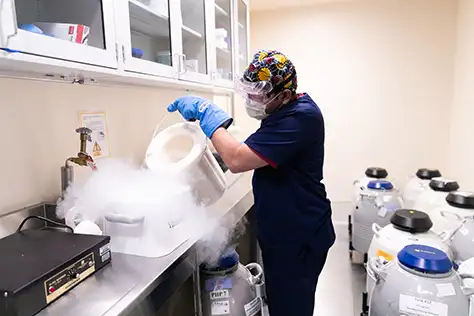Freeze All IVF
The benefits of the "freeze all" approach to IVF.
Freeze All IVF for a Higher Chance of Success

Stimulated IVF cycles involve multiple steps—stimulating the ovaries, retrieving the eggs, fertilizing the eggs with the sperm in the lab, and finally, transferring the embryo(s) to the patient’s uterus. In a freeze all IVF cycle, the patient goes through all of those steps, except the transfer; instead, we freeze all the embryos that we create in the IVF lab and wait a month (or more) to transfer the embryos to the uterus.
What Are the Benefits of Waiting to Transfer Frozen Embryos?
The physicians at Dallas-Fort Worth Fertility Associates believe that one of the main benefits of waiting is that it gives the patient's uterus a chance to recover from the ovarian stimulation required to produce multiple eggs. Ovarian stimulation can cause problems with implantation as well as an increased risk for ovarian hyperstimulation syndrome (OHSS).
When the embryo(s) are frozen, the transfer is done without ovarian stimulation, giving the uterus a chance to return to its pre-stimulation state. This also improves endometrial receptivity, which can improve the chances for a successful embryo implantation.
Is There Research that Supports Freeze All IVF Cycles?
A study presented at the European Society of Human Reproduction and Embryology* in July, 2012 states that a freeze all IVF cycle (where all the embryo(s) are frozen and transferred later) results in an approximately 30% greater chance of achieving a clinical pregnancy. This evidence supports the use of frozen embryo transfer (FET), but it doesn’t mean that all fresh embryo transfers are going to be replaced by freeze all IVF cycles. At Dallas-Fort Worth Fertility Associates, we always discuss these important decisions with each patient and make a decision based on each individual’s needs and circumstances.
What Are the Possible Risks of Freeze All IVF?
There is great news about the technology used to freeze embryos—it’s vastly improved in the last five years thanks to vitrification. Vitrification is a fast-freezing method that has a very high success rate, ensuring that approximately 98% of embryos will survive the process. Frozen embryos have been used since the 1980s, and research shows children born from frozen embryos don’t have any problems related to the frozen embryo state.
At Dallas-Fort Worth Fertility Associates, we pride ourselves on keeping up to date with the latest research in the field of infertility. Our physicians are involved in their own research, as well. We want our patients to know more about infertility treatment, and we encourage you to learn what’s involved in a freeze all IVF cycle. Contact us to make an appointment to explore the wonderful options available to you as you create your loving family.
*This study was presented on July 4, 2012 at the European Society of Human Reproduction and Embryology meeting by Professor Miguel Angel Checa from the Hospital Universitari del Mar, Barcelona, Spain.
Sources for this webpage:
https://www.sciencedaily.com/releases/2012/07/120704124319.htm